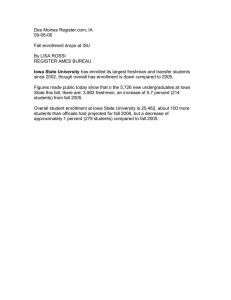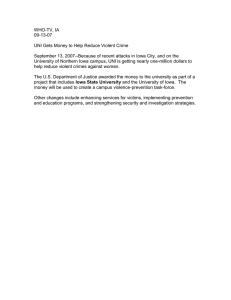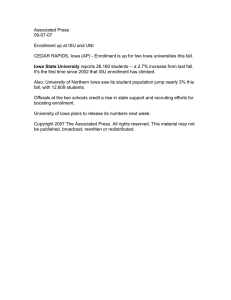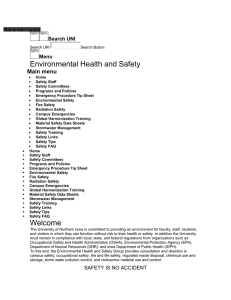Enrollment Summit July 12, 2012 Maucker Union University Room
advertisement
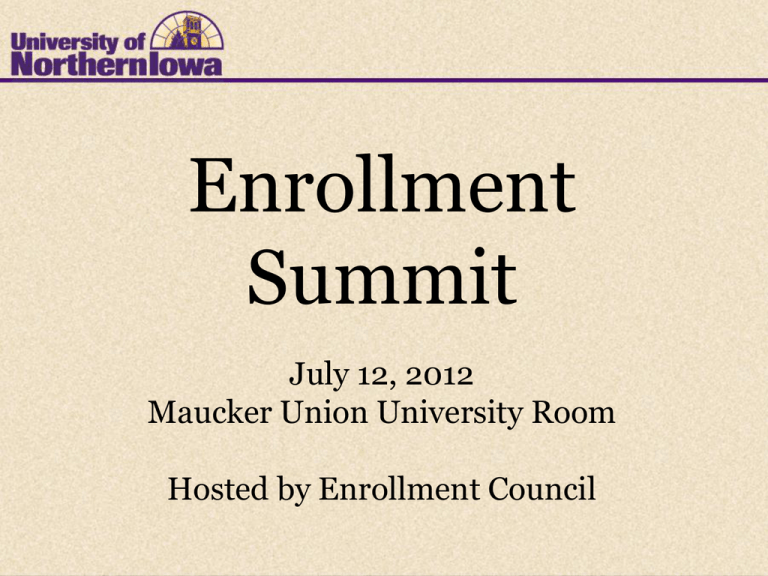
Enrollment Summit July 12, 2012 Maucker Union University Room Hosted by Enrollment Council Welcome and overview Gloria Gibson, Provost On behalf of the Enrollment Council . . . Ben Allen James O'Connor Cliff Chancey Michael Hager Terry Hogan Shashi Kaparthi Gloria Gibson Phil Patton Joel Haack KaLeigh White Christie Kangas Joyce Morrow Kent Johnson Michael Licari Dwight Watson Craig Klafter Bruce Rieks President (Chair) Executive Director, University Relations Head, Department of Physics Vice President, Administration & Financial Services Vice President, Student Affairs (Vice Chair) Director, Institutional Research and CIO Provost and Executive Vice President University Registrar Dean, College of Humanities, Arts & Sciences Vice President, Northern Iowa Student Government Director, Admissions Director, Student Financial Aid Dean, Continuing Education & Special Programs Associate Provost, Academic Affairs & Dean, Graduate College Dean, College of Education Associate Provost, International Programs Director. Budget Development Our goal To broaden engagement across campus in the process of building enrollment . . . By devoting time to 1. Examining current demographic, public policy, competitive and fiscal environments; 2. Learning about current student recruitment practice; and 3. Discussing strategies and tactics that would foster progress. With a limitation 1. Focus on resident, undergraduate enrollment; 2. Includes students direct from high school and transfers. Agenda 9:00 – 9:20 am 9:20 – 10:15 am 10:15 – 10:30 am 10:30 – 11:00 am 11:00 am – noon Welcome & overview Gloria Gibson, Provost Environmental scan: Why is enrollment important and challenging? Ben Allen, President BREAK Current enrollment: What pieces make up the whole? Shashi Kaparthi, Chief Information Officer Current program: How do we generate our current enrollment? Terry Hogan, Vice President, Student Affairs Agenda (continued) 12:00 – 12:15 pm 12:15 – 1:15 pm 1:15 – 1:30 pm 1:30 – 2:30 pm 2:30 – 3:30 pm BREAK – Boxed lunches in the hallway Best practice: Examples from UNI colleges CHAS – Joel Haack COE – Mary Herring CSBS – Brenda Bass and Rowena Tan CBA – Leslie Wilson BREAK Small group discussion How do we improve? Open forum Environmental scan: Why is enrollment important and challenging? Ben Allen, President Four factors in current environment 1. 2. 3. 4. Public policy Demography Competition Costs of higher education Public policy shifts 1. Implementation of Senior Year Plus 2. Expansion of community college articulation agreements 3. Continuation of Iowa Tuition Grant 4. Reduction of state appropriations 5. Elimination of tuition set-aside Public policy shifts 1. Implementation of Senior Year Plus – Legislation that encourages earning of college credit by current high school students. Impact: Connects high school students to community colleges early. New freshman with accepted community college credit prior to enrollment 70.00% 64% 57.80% 60.00% 59.40% 50.60% Percentage of Students 50.00% 40.00% 30.00% 36.60% 29.40% 29.10% 2000 2001 46.40% 47.00% 2004 2005 38.90% 20.00% 10.00% 0.00% 2002 2003 Fall 2006 2007 2008 2009 Public policy shifts 2. Expansion of community college articulation agreements – Encourages seamless pathways from Iowa community college coursework and degrees to bachelor’s degree attainment at Regents institutions. Impact: Easier for students to shop for less expensive and/or less rigorous credits. Iowa community college fall enrollments 140,000 120,000 Students Enrolled 100,000 80,000 60,000 40,000 20,000 - Year Source: http://educateiowa.gov/index.php?option=com_content&view=article&id=252&catid=183&Itemid=2182 Transfer enrollment at UNI Public policy shifts 3. Continuation of Iowa Tuition Grant – Provides financial aid to Iowa students who choose to attend a private college in Iowa Impact: Along with private colleges’ ability to discount tuition (average is 42%), makes cost of attendance much more competitive with Regents institutions. Funding for Iowa Tuition Grant Public policy shifts 4. Reduction of state appropriations – Systematic reduction over time of public support to Regents institutions. Impact: Increases in tuition create challenges for students to choose us and to remain with us through degree completion. Changes in State Appropriations and Tuition Revenue 80.0% 70.7% 71.2% 71.2% 71.2% 71.1% 71.6% 70.0% 68.1% 63.6% 59.1% 60.0% 57.6% 58.7% 57.8% 59.1% 59.5% 53.0% 50.7% 52.3% 50.0% 47.0% 40.0% 40.9% 42.4% 41.3% 42.2% 49.3% 47.7% 40.9% 40.5% 36.4% 30.0% 29.3% 28.8% 28.8% 28.8% 28.9% 28.4% 31.9% 20.0% FY96 FY97 FY98 FY99 FY00 FY01 FY02 FY03 FY04 FY05 FY06 FY07 FY08 FY09 FY10 FY11 FY12 State Funding Tuition Funding Source: Board of Regents, State of Iowa Reports Public policy shifts 5. Elimination of tuition set-aside – Current effort to limit Regents institutions’ ability to use tuition funds to provide financial aid. Impact: Disproportionate negative effect on UNI as our students have lower socioeconomic status compared to Iowa/ISU; impacts our ability to compete for quality students. Four factors in current environment 1. 2. 3. 4. Public policy Demography Competition Costs of higher education Iowa high school graduates 42,000 40,986 41,000 Graduating Students 40,313 39,976 40,000 39,000 39,591 38,613 39,688 39,361 38,865 38,872 38,488 38,394 38,000 37,477 37,326 37,428 37,290 37,000 36,000 35,000 Year Source: http://educateiowa.gov/index.php?option=com_docman&task=cat_view&gid=511&Itemid=1563 Four factors in current environment 1. 2. 3. 4. Public policy Demography Competition Costs of higher education Destinations for Fall 2011 freshman admits who did not enroll at UNI Iowa State 16.06% 226 students University of Iowa 13.23% 183 students Wartburg 4.48% 63 students Des Moines Area CC 3.77% 53 students Kirkwood CC 3.41% 48 students Central College 2.92% 41 students Hawkeye CC 2.35% 33 students Simpson College 1.92% 27 students Luther College 1.78% 25 students Drake University 1.75% 25 students Hawkeye Community College While a previous advertisement asked “Got Class?” this Hawkeye Community College billboard on University Avenue near Main Street holds the same location with a different message. Kirkwood Newspaper Insert in Northern Iowan This postcard sized newspaper insert was placed by Kirkwood in the Northern Iowan earlier this summer. Clarke University Billboard on University Avenue This billboard boasting 100% placement of elementary teachers is located on University Avenue by the Jiffy Lube facing westbound traffic. It is one of three from Clarke that have appeared in last two months. Wartburg College Commercial: Dependability, Stability, and Possibility This Wartburg TV advertisement was published to their YouTube channel as well on April 30th, 2012 and is currently running on local cable television. University of Iowa/Iowa State University Presidents Mason and Leath have made very recent public statements about their desire to increase enrollment of Iowa undergraduates. Both have made significant investments in paid advertising and admissions staffing. Admissions staffing Iowa ISU 62 62 UNI 21 Source: Staff listings on respective websites Four factors in current environment 1. 2. 3. 4. Public policy Demography Competition Costs of higher education UNI tuition/fees cost $9,000 $8,000 $7,000 Dollars $6,000 $5,387 $5,602 $5,912 $6,190 $6,376 $6,636 $7,008 $7,350 $7,635 $4,916 $5,000 $4,118 $4,000 $3,000 $3,130 $2,860 $2,988 $3,440 $2,000 $1,000 $0 Academic Year Source: Financial Aid Undergraduates receiving Pell grants 35.0% 29.7% 30.0% 26.2% Percentage of Students 25.9% 25.0% 23.5% 23.0% 24.0% 27.0% 26.4% 25.9% 24.7% 23.3% 23.0% 23.2% 20.0% 15.0% 10.0% 5.0% 0.0% 1998-99 1999-00 2000-01 2001-02 2002-03 2003-04 2004-05 2005-06 2006-07 2007-08 2008-09 2009-10 2010-11 Academic Year Source: Financial Aid UNI’s Pell coverage rate 120.0% 104.9% 104.6% 105.4% Percentage of Tuition Covered 100.0% 109.0% 97.1% 82.4% 80.0% 75.2% 72.3% 68.5% 69.6% 74.2% 80.6% 79.2% 75.5% 72.7% 60.0% 40.0% 20.0% 0.0% Academic Year Source: Financial Aid Average student debt at graduation $30,000 $25,735 $25,523 $24,176 $24,123 $25,000 $21,561 $22,541 $20,239 Dollars of Debt $20,000 $15,000 $18,397 $14,772 $15,168 $15,439 $16,013 $16,716 $10,000 $5,000 $0 1998-99 1999-00 2000-01 2001-02 2002-03 2003-04 2004-05 2005-06 2006-07 2007-08 2008-09 2009-10 2010-11 Academic Year Source: Financial Aid Colleges with space available after May 1st Current enrollment: What pieces make up the whole? Shashi Kaparthi, Chief Information Officer Fall 2011 Students by Academic Career/Residency 2% 3% 1% 10% 4% Undergrad Resident Undergrad Non-Resident Undergrad International Graduate Resident Graduate Non-Resident Graduate International 80% Fall Enrollment 14500 14000 13,926 13,441 13500 13,201 13,168 2010 2011 Students 13,080 13000 12,908 12,824 12,609 12,513 12500 12,260 12000 11500 11000 2002 2003 2004 2005 2006 2007 Fall Semester 2008 2009 New Freshman vs New Transfers 2500 2,263 2,104 1,991 Enrolled Students 2000 1,865 1,785 1,700 1,737 2,015 1,946 1,978 1,937 1,768 1500 1,167 1,235 1,119 1,201 1,097 1,080 1,117 1,077 1,052 1,088 1,138 1,041 1000 500 0 2000 2001 2002 2003 2004 2005 2006 Fall Semester New Freshman Transfers 2007 2008 2009 2010 2011 Breakdown of UGs by Residency 14000 12000 11,536 11,754 11,504 11,061 10,516 10,185 Enrolled Students 10000 9,907 10,157 10,185 10,469 10,532 10,522 8000 6000 4000 2000 498 184 529 191 571 207 507 206 516 188 537 230 542 253 555 298 598 264 541 284 526333 541345 2000 2001 2002 2003 2004 2005 2006 2007 2008 2009 2010 2011 0 Fall Semester Resident Non-Resident International UG Minority vs Non-Minority 12000 11,023 10,498 9,978 10000 9,740 9,463 9,679 9,758 10,152 10,192 10,123 Students 8000 6000 4000 2000 648 668 668 620 631 628 648 767 742 815 0 2002 2003 2004 2005 2006 2007 Fall Semester Non-Minority * Excludes International Students Minority 2008 2009 2010 2011 Average ACT of New Freshman 23.3 23.2 23.2 23.1 ACT Composite Score 23.1 23 23 23 22.9 22.9 22.9 22.9 22.8 22.8 22.8 2005 2006 22.8 22.7 22.6 2002 2003 2004 2007 Fall Semester 2008 2009 2010 2011 Retention Rate of New Freshman 84 83.7 83.5 83 82.5 82.5 82.3 82.3 Retention Rate 82.1 82 82 81.5 81.4 81.4 80.9 81 80.6 80.5 80 79.5 79 2001 2002 2003 2004 2005 2006 Cohort Year 2007 2008 2009 2010 4-Year Graduation Rate 40 37.7 35 Graduation Rate 30 33.5 33.9 1999 2000 32.3 35.2 35.2 35.7 2003 2004 2005 36.8 33.5 29.5 25 20 15 10 5 0 1998 2001 2002 Cohort Year 2006 2007 Top 10 Majors (Fall 2011) Program Enrollment Elementary Education 1400 Accounting 589 Early Childhood Education 482 Psychology 459 Management: Business Administration 413 Biology 411 Finance 385 Marketing 364 Criminology 340 Movement and Exercise Science 326 Top 10 Majors of New Students (Fall 2011) Program Enrollment Elementary Education 317 Accounting 182 Psychology 141 Early Childhood Education 110 Criminology 103 Management: Business Administration 101 Biology 90 Business Potential 75 Marketing 74 Social Work 74 Top Sources of New Transfer Students (Fall 2011) School Number of Students Hawkeye Community College 210 Kirkwood Community College 147 North Iowa Area Community College 79 Des Moines Area Community College 65 Iowa Central Community College 60 University of Iowa 51 Indian Hills Community College 40 Iowa State University 32 Northeast Iowa Community College 29 Iowa Lakes Community College 19 Current program: How do we generate current enrollment? Terry Hogan, Vice President, Student Affairs The recruitment funnel . . . Awareness Prospect Applicant Admit Matriculant Recruitment advertising Print/online ads in college guides, directories NEW: Online ads via Google Search NEW: Online banner ads NEW: Billboards/mall banners Occasional TV Google search result Web Banner Ad Billboard Prospect development Purchase of targeted mailing lists NEW: Segment high ability for Honors Program effort Contact cards collected during visits/fairs Inquiries collected via website, third-party providers, campus programs/camps, phone call Leads to initiation of prospect communication program Web presence/tools NEW: Redesigned Admissions site Facebook YouTube NEW: Redesigned Financial Aid site Plans of Study Transfer Planet Financial aid calculator Campus visit programs Face-to-face meetings with Admissions counselors, advisors, faculty Campus tours Visits to colleges/academic programs, residence halls, dining halls Peer interaction via SAA, ESP and ISP Group visits/visit events (Panther Peek Days) Counselor recruitment Admissions counselors assigned to geographic territories College-based recruiters pursue targeted prospects Regional reps deployed to Twin Cities and Chicago Visits made to high schools, community colleges, fairs, other events Counselor recruitment (cont) Relationships developed with high school/CC counselors Prospects assigned to personal counselor Direct contact/follow-up to prospect inquiries NEW: Webinars used for interaction with outlying schools Peer telecounseling STARS – peers who provide targeted outreach calls after hours Call Center – peers who respond to telephone inquiries NEW: Student organizations tapped to make targeted calls Application processing/response All undergraduate applications on-line Provide immediate email acknowledgment of application Assess transferability of credit NEW: Provide admission decision within 72 hours Leads to initiation of yield communication program Pipeline/targeted initiatives Gary Community School District, Gary, IN Palo Alto Community College District, San Antonio, TX Transfers, multicultural, high ability, international Best practices at UNI colleges College of Humanities, Arts & Sciences College of Education Diversity Initiatives COE Strategic Plan • GOAL 3: – Create, maintain, and enhance a culture that is characterized by a proactive commitment to diversity, collegiality, and mutual respect. COE Website Prospective Student’s Page • A commitment to diversity. We embrace all people, regardless of race, ethnicity, national origin, gender, sexual orientation, religion, age or ability – and teach our students to do the same. In our ever-changing world, this commitment becomes more and more important as you work with diverse populations. http://www.uni.edu/coe/prospective-students COE Recruitment, Retention, and Advising Position • 40%: Advising students • 30%: Coordinates Orientations and Transfer sessions • 20%: Retention work with COE students of color • 10%: Recruitment Activities Goals/Metrics • Increase # of students of color • Increase Multicultural Teaching Alliance membership • Participate in ongoing recruitment and advising activities with COE Advising Staff • Represent and incorporate other COE participants on multicultural initiatives Things We Would Change • Job description: 60% Recruitment; 40% Retention • Campus Training: join Admissions Counselor training sessions • Data collection: List available data from Admissions Office • College Fairs • January 15 Scholarship Cutoff Date Dr. Heather Hackman • Diversity, Cultural Competency and Social Justice Education: An Introduction to the Similarities and Critical Difference with Respect to Effective Racial Justice Work Dr. Heather Hackman • Diversity IS NOT about power, privilege or access to resources. And, since these are core elements of every form of oppression, a “diversity” approach is doomed to never effectively address racism. • Social Justice first, addressing Power and Privilege Dr. Heather Hackman Change • Faculty hiring, recruitment, and retention-average stay is two years • Faculty training-proof is in the syllabus • Candidate selection-more than GPA/ACT • Weave throughout curriculuminterdisciplinary • Community-deep relationships inside and outside university College of Social & Behavioral Sciences Scholarship Days COLLEGE OF SOCIAL AND BEHAVIORAL SCIENCES Scholarship Days Purpose of Scholarship Day Showcase programs in CSBS Attract high achieving students to CSBS Allow students to meet and talk with faculty and committee In depth look at UNI Hear experiences from similar students Format V1 (circa 2000) CSBS Scholarship day All day event (8:00 AM to 3:30 PM) Student Panels and information tables Campus tours Lunch Interviews Issues with V1—students’ view “This is the fifth time I’ve been on campus this year… I’ll be back next week for more interviews” Students miss too much school Parents often take a day off of work “We had to leave the house at 4AM to get here” Tours and Info Tables: “Been there, done that…can I go to the bookstore?” Issues with V1: Our View Scheduling, Scheduling, Scheduling, Scheduling, Scheduling, Scheduling, Scheduling, Scheduling, Scheduling, Scheduling, Scheduling, Scheduling, Faculty and student volunteers More students were requesting an alternate format (phone interviews) or a different day Lunch arrangements Giving students and parents a more unique experience (for the 4th time) New and Improved! What are other times the students come to campus? UpClose Day! Up-Close Day provides Parking Information tables Campus tours Lunch Flexibility in schedule New Format “It was nice to have a place to relax during the busy day. It was fun to meet some of the other students, too.” Meet at a showcase room after lunch Mingle with current scholars, faculty, and scholarship committee Have students bring them to interviews in faculty offices Benefits of the New Format We have other campus divisions do what they do best, and we devote more time to engaging the student. Good place to relax with a busy day Students can use other times to meet with family and friends or go to sessions on campus Students will be finished before 2PM Availability of students and faculty Built-in make up day Important things to consider ! Working with other divisions on campus to avoid overlap Communication is important Assume that many people won’t read instructions Bottom Line Creates an experience more focused on the individual Allows the colleges to invest time in what they do best Develops a partnership between Student Affairs and Academic Affairs College of Business Administration Small Group Discussion 1. What might we do to increase enrollment? 2. How might working relationships between colleges, academic departments and Admissions be improved to help increase enrollment? Open Forum 1. Share results of small group discussion . . . 2. Additional thoughts, ideas, concerns or questions?
